Install
No edit summary |
No edit summary |
||
| (14 intermediate revisions by 2 users not shown) | |||
| Line 1: | Line 1: | ||
= | [[File:Windbird.jpg|thumb|link=/wiki/File:Windbird.jpg]] | ||
= '''<big><span lang="en" dir="ltr">Installation</span></big>''' = | |||
== '''''<span lang="en" dir="ltr">Installation prerequisites</span>''''' == | |||
== Important == | === '''<span lang="en" dir="ltr">Important: Windbird calibration</span>''' === | ||
<span lang="en" dir="ltr">It is mandatory to calibrate the Windbird before installing it.</span> | |||
== | <span lang="en" dir="ltr">Windbird calibration process is described on this page in the paragraph: "[[Install#Windbird calibration|Calibrating the Windbird]]".</span> | ||
'''<big><span lang="en" dir="ltr">Unpacking</span></big>''' | |||
<span lang="en" dir="ltr">The Windbird box contains 4 items:</span> | |||
* <span lang="en" dir="ltr">Windbird anemometer</span> | |||
* <span lang="en" dir="ltr">USB computer update cable</span> | |||
* <span lang="en" dir="ltr">A bag containing a bracket and screws for mounting the instrument</span> | |||
* <span lang="en" dir="ltr">A document to guide you through Windbird commissioning</span> | |||
<span lang="en" dir="ltr">The Windbird has been packaged in a cardboard box for transport, which should be disposed of in the recycling bin.</span> | |||
<span lang="en" dir="ltr">The product has been protected by bubble wrap to prevent breakage, and should be disposed of in the waste bin.</span> | |||
<span lang="en" dir="ltr">The Windbird contains a battery which should not be disposed of in the waste bin, but in a recycling bin dedicated to batteries.</span> | |||
=== '''<span lang="en" dir="ltr">Serial number record</span>''' === | |||
<span lang="en" dir="ltr">Each Windbird has a unique serial number. This number is marked on the tail.</span> | |||
<span lang="en" dir="ltr">The serial number is the "identity" of your Windbird. It is important to record this number and write it down on a piece of paper for safekeeping.</span> | |||
<span lang="en" dir="ltr">This number allows you to quickly access wind measurements on the [https://www.openwindmap.org/ OpenWindMap] website, renew your Sigfox subscription or contact customer service for technical support.</span> | |||
== '''<big>''<span lang="en" dir="ltr">Location choice</span>''</big>''' == | |||
[[File:Pose.jpg|thumb|link=/wiki/File:Pose.jpg]] | |||
Obstacles such as trees or buildings create turbulences which interferes with wind measurement. Make sure the Windbird has an unobstructed view. | |||
Place the Windbird away from obstacles to improve radio transmission of wind measurements. | |||
Make sure the Windbird has a complete 360-degree clearance to ensure reliable wind measurements in all directions. | |||
== '''< | == <big><span lang="en" dir="ltr">'''''Pole choice'''''</span></big> == | ||
[[File: | [[File:Vent.jpg|thumb|link=/wiki/File:Vent.jpg]] | ||
The Windbird must be at least 2 metres above the ground or roof on which it is installed. The higher the Windbird be placed, the less obstacles will interfere with the measurement. Radio transmission of wind measurements is improved when the Windbird is placed high up. | |||
As a guide, here are the heights generally used: | |||
* Meteorology: 10m above ground level | |||
* Aviation: 10m above ground level | |||
* Agriculture: 2m above ground level (for evapotranspiration calculations) | |||
For "leisure" use, a 4.60m "windsurfing" mast is usually sufficient. | |||
An 8m wooden, galvanized steel or composite pole is a very good choice for installing a Windbird (ex telephone pole). | |||
== '''<big>''<span lang="en" dir="ltr">Fastening</span>''</big>''' == | |||
The Windbird can be mounted on a bracket in a number of ways: | |||
* With a bracket | |||
* With plastic clamps | |||
* With screws and washers | |||
It's important to choose the right mounting system beforehand. | |||
The mounting bracket must be adapted to the fastening system: a tube is preferable for bracket or plastic clamp fastening. | |||
For screw fastening system, a resistant material should be used as the fastening support, with screws and washers of the appropriate size. Where a hole has to be drilled in the fastening support, plugs must be used, and their diameter must be carefully selected according to the material. | |||
It's important to use the correct torque for any fastening system, to ensure that the Windbird is held securely without damaging the plastic fastener. | |||
[[File:Fixation_etrier.jpg|left|thumb|200x200px|'''<span lang="en" dir="ltr">Bracket (supplied)</span>'''|link=/wiki/File:Fixation_etrier.jpg]] | |||
[[File:Fixation_vis.jpg|thumb|200x200px|'''<span lang="en" dir="ltr">Screws and washers (not supplied)</span>'''|link=/wiki/File:Fixation_vis.jpg]] | |||
[[File:Fixation_colliers.jpg|center|thumb|200x200px|'''<span lang="en" dir="ltr">Plastic clamps (not supplied)</span>'''|link=/wiki/File:Fixation_colliers.jpg]] | |||
= '''<span lang="en" dir="ltr">Operation</span>''' = | |||
[[File:Demarrage.jpg|thumb|link=/wiki/File:Demarrage.jpg]] | |||
== '''''<span lang="en" dir="ltr">Multi-purpose control button</span>''''' == | |||
<span lang="en" dir="ltr">The Windbird has a single button for starting, stopping and calibrating.</span> | |||
<span lang="en" dir="ltr">The multi-purpose button is located on the underside of the device. It can be pressed with the tip of a pen.</span> | |||
== | <span lang="en" dir="ltr">The length of time the multi-purpose button is pressed determines the action performed:</span> | ||
<span lang="en" dir="ltr">Short press -> Start or Stop Windbird</span> | |||
<span lang="en" dir="ltr">Press for 10 seconds -> Start calibration</span> | |||
<span lang="en" dir="ltr">An LED lamp is located next to the button, flashing according to the Windbird's status.</span> | |||
== '''''<span lang="en" dir="ltr">Windbird calibration</span>''''' == | |||
<span lang="en" dir="ltr">When using Windbird for the first time, or if you find that it is giving you the wrong direction, it is necessary to calibrate the Windbird :</span> | |||
* <span lang="en" dir="ltr">Switch on Windbird</span> | |||
* <span lang="en" dir="ltr">Press and hold the button until the LED starts flashing rapidly (approx. 10 seconds).</span> | |||
* <span lang="en" dir="ltr">The LED flashes for 5 seconds, to give you time to prepare for calibration.</span> | |||
* <span lang="en" dir="ltr">When the LED becomes steady, calibration begins. Rotate Windbird around its axis until the LED goes out (approx. 15 seconds). The aim is to make at least 3 turns. For the wind vane to work properly, Windbird's axis must always be as vertical as possible throughout the calibration process. The Windbird works with a compass. It may be affected by strong magnetic fields (e.g. near power lines or base stations).</span> | |||
== '''''Start''''' == | |||
Briefly press the button. The LED lights up steadily for a few seconds to confirm device start-up. | |||
About 10 seconds later, your Windbird should appear "online" on the website or mobile application. | |||
The first measurements and position will be transmitted about fifteen minutes after switching on. This may take a little longer if GPS reception is poor. | |||
The LED may light up, but Windbird may not appear online, even after 30 seconds. This means that Windbird is not receiving the Sigfox network in that area. Try again at another location. | |||
== '''''Stop''''' == | |||
<span lang="en" dir="ltr">- When your Windbird is switched on, briefly press the button. The LED will flash 5 times to indicate shutdown.</span> | |||
<span lang="en" dir="ltr">Around 10 seconds after shutdown, Windbird should appear "offline" on the website or mobile app.</span><span lang="en" dir="ltr"> </span> | |||
= '''<span lang="en" dir="ltr">Maintenance</span>''' = | |||
== ''' | == '''''<small><span lang="en" dir="ltr">Battery</span></small>''''' == | ||
<span lang="en" dir="ltr">Windbird contains a high-performance battery that can withstand extreme temperatures.</span> | |||
== | <span lang="en" dir="ltr">Battery life is approximately 4 years. Numerous parameters may vary this duration.</span> | ||
== '''''<span lang="en" dir="ltr">Bearings</span>''''' == | |||
The Windbird's bearings are maintenance-free and designed to run dry. Do not add oil or grease, as this may interfere with measurements. | |||
It is nevertheless recommended to replace the bearings at the same time as the battery to maintain a high level of performance in wind measurements. | |||
== '''''<span lang="en" dir="ltr">Sigfox network</span>''''' == | |||
Your Windbird automatically connects to the Internet via the Sigfox radio network. There are no settings to make. Subscription is included for the first year, and can be renewed on the [https://www.openwindmap.org/ OpenWindMap] website. | |||
This network offers similar coverage to GSM. Windbird can therefore operate reliably. However, some areas may not be covered. | |||
There are no borders: a Windbird purchased in France will automatically work in Spain or the Netherlands. The reverse also works. | |||
== '''''<span lang="en" dir="ltr">Spare parts</span>''''' == | |||
''' | |||
Spare parts are available to repair each Windbird component in the event of breakage or damage. | |||
The Windbird battery should be purchased about every 4 years, and replaced before reaching the maximum discharge level. | |||
= '''<span lang="en" dir="ltr">Technical details</span>''' = | |||
== '''''<span lang="en" dir="ltr">Geolocation</span>''''' == | |||
<span lang="en" dir="ltr">Windbird is equipped with a GPS chip to update its position on the map.</span> | |||
<span lang="en" dir="ltr">The location functionality is activated automatically :</span> | |||
=== | * <span lang="en" dir="ltr">on power-up, for a maximum of 15 minutes</span> | ||
* <span lang="en" dir="ltr">once every 4 days, for a maximum of 1 minute.</span> | |||
<span lang="en" dir="ltr">To work properly, the GPS needs a clear view of the sky. It can sometimes fail if your Windbird is at the bottom of a deep valley, close to trees, too close to a building, or in bad weather.</span> | |||
== '''''<span lang="en" dir="ltr">Transmissions des mesures</span>''''' == | |||
<span lang="en" dir="ltr">Windbird measures wind direction and speed during two 5-minute periods. Measurements are transmitted to the Internet every 10 minutes.</span> | |||
== '' | |||
= | |||
Latest revision as of 00:36, 6 October 2023
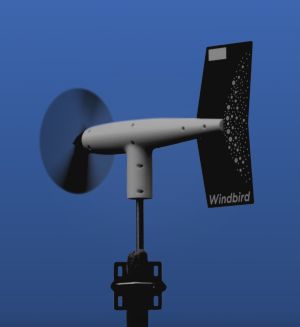
Installation
Installation prerequisites
Important: Windbird calibration
It is mandatory to calibrate the Windbird before installing it.
Windbird calibration process is described on this page in the paragraph: "Calibrating the Windbird".
Unpacking
The Windbird box contains 4 items:
- Windbird anemometer
- USB computer update cable
- A bag containing a bracket and screws for mounting the instrument
- A document to guide you through Windbird commissioning
The Windbird has been packaged in a cardboard box for transport, which should be disposed of in the recycling bin.
The product has been protected by bubble wrap to prevent breakage, and should be disposed of in the waste bin.
The Windbird contains a battery which should not be disposed of in the waste bin, but in a recycling bin dedicated to batteries.
Serial number record
Each Windbird has a unique serial number. This number is marked on the tail.
The serial number is the "identity" of your Windbird. It is important to record this number and write it down on a piece of paper for safekeeping.
This number allows you to quickly access wind measurements on the OpenWindMap website, renew your Sigfox subscription or contact customer service for technical support.
Location choice
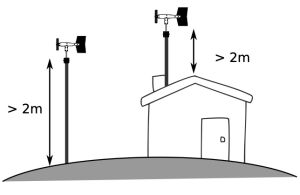
Obstacles such as trees or buildings create turbulences which interferes with wind measurement. Make sure the Windbird has an unobstructed view.
Place the Windbird away from obstacles to improve radio transmission of wind measurements.
Make sure the Windbird has a complete 360-degree clearance to ensure reliable wind measurements in all directions.
Pole choice
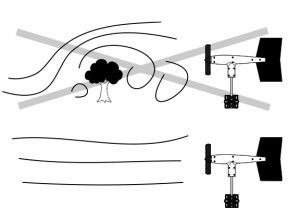
The Windbird must be at least 2 metres above the ground or roof on which it is installed. The higher the Windbird be placed, the less obstacles will interfere with the measurement. Radio transmission of wind measurements is improved when the Windbird is placed high up.
As a guide, here are the heights generally used:
- Meteorology: 10m above ground level
- Aviation: 10m above ground level
- Agriculture: 2m above ground level (for evapotranspiration calculations)
For "leisure" use, a 4.60m "windsurfing" mast is usually sufficient.
An 8m wooden, galvanized steel or composite pole is a very good choice for installing a Windbird (ex telephone pole).
Fastening
The Windbird can be mounted on a bracket in a number of ways:
- With a bracket
- With plastic clamps
- With screws and washers
It's important to choose the right mounting system beforehand.
The mounting bracket must be adapted to the fastening system: a tube is preferable for bracket or plastic clamp fastening.
For screw fastening system, a resistant material should be used as the fastening support, with screws and washers of the appropriate size. Where a hole has to be drilled in the fastening support, plugs must be used, and their diameter must be carefully selected according to the material.
It's important to use the correct torque for any fastening system, to ensure that the Windbird is held securely without damaging the plastic fastener.
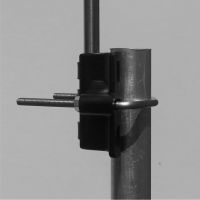
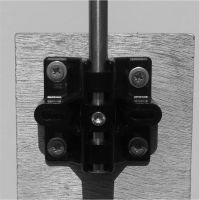
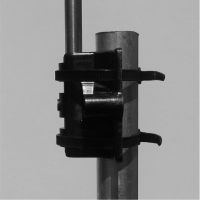
Operation
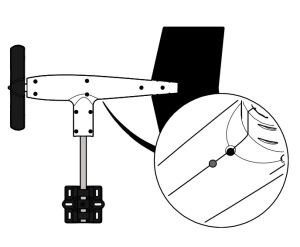
Multi-purpose control button
The Windbird has a single button for starting, stopping and calibrating.
The multi-purpose button is located on the underside of the device. It can be pressed with the tip of a pen.
The length of time the multi-purpose button is pressed determines the action performed:
Short press -> Start or Stop Windbird
Press for 10 seconds -> Start calibration
An LED lamp is located next to the button, flashing according to the Windbird's status.
Windbird calibration
When using Windbird for the first time, or if you find that it is giving you the wrong direction, it is necessary to calibrate the Windbird :
- Switch on Windbird
- Press and hold the button until the LED starts flashing rapidly (approx. 10 seconds).
- The LED flashes for 5 seconds, to give you time to prepare for calibration.
- When the LED becomes steady, calibration begins. Rotate Windbird around its axis until the LED goes out (approx. 15 seconds). The aim is to make at least 3 turns. For the wind vane to work properly, Windbird's axis must always be as vertical as possible throughout the calibration process. The Windbird works with a compass. It may be affected by strong magnetic fields (e.g. near power lines or base stations).
Start
Briefly press the button. The LED lights up steadily for a few seconds to confirm device start-up.
About 10 seconds later, your Windbird should appear "online" on the website or mobile application.
The first measurements and position will be transmitted about fifteen minutes after switching on. This may take a little longer if GPS reception is poor.
The LED may light up, but Windbird may not appear online, even after 30 seconds. This means that Windbird is not receiving the Sigfox network in that area. Try again at another location.
Stop
- When your Windbird is switched on, briefly press the button. The LED will flash 5 times to indicate shutdown.
Around 10 seconds after shutdown, Windbird should appear "offline" on the website or mobile app.
Maintenance
Battery
Windbird contains a high-performance battery that can withstand extreme temperatures.
Battery life is approximately 4 years. Numerous parameters may vary this duration.
Bearings
The Windbird's bearings are maintenance-free and designed to run dry. Do not add oil or grease, as this may interfere with measurements.
It is nevertheless recommended to replace the bearings at the same time as the battery to maintain a high level of performance in wind measurements.
Sigfox network
Your Windbird automatically connects to the Internet via the Sigfox radio network. There are no settings to make. Subscription is included for the first year, and can be renewed on the OpenWindMap website.
This network offers similar coverage to GSM. Windbird can therefore operate reliably. However, some areas may not be covered.
There are no borders: a Windbird purchased in France will automatically work in Spain or the Netherlands. The reverse also works.
Spare parts
Spare parts are available to repair each Windbird component in the event of breakage or damage.
The Windbird battery should be purchased about every 4 years, and replaced before reaching the maximum discharge level.
Technical details
Geolocation
Windbird is equipped with a GPS chip to update its position on the map.
The location functionality is activated automatically :
- on power-up, for a maximum of 15 minutes
- once every 4 days, for a maximum of 1 minute.
To work properly, the GPS needs a clear view of the sky. It can sometimes fail if your Windbird is at the bottom of a deep valley, close to trees, too close to a building, or in bad weather.
Transmissions des mesures
Windbird measures wind direction and speed during two 5-minute periods. Measurements are transmitted to the Internet every 10 minutes.